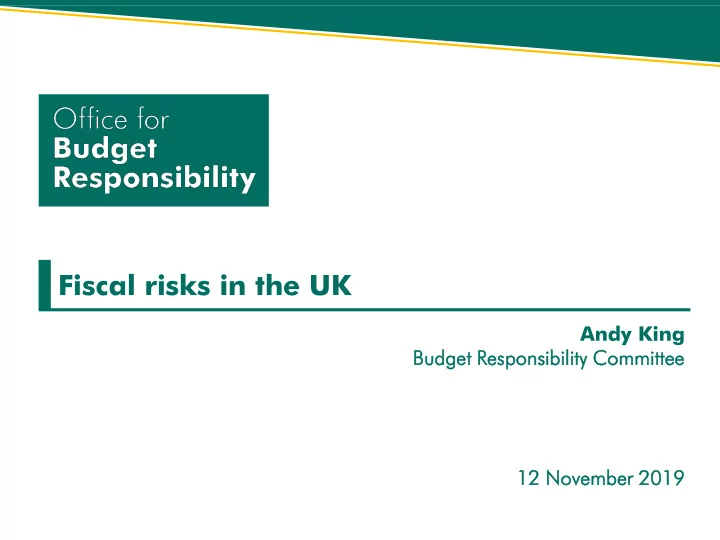

Fiscal risks in the UK Andy King Budget t Respons onsibilit bility y Comm mmittee ttee 12 November vember 2019 19
Introduction
Background • The IMF said in 2016 that “summary reporting of specific risks is a weakness that should be addressed” • The Government then legislated for us to produce an FRR every two years, to which it is obliged to respond • We published our first FRR in July 2017 and the Treasury responded with Managing fiscal risks in July 2018 • Several other countries produce risk reports, but usually by their finance ministries or cabinet offices
Our approach • The IMF defines fiscal risks as – “the possibility of deviations of fiscal outcomes from what was expected at the time of the Budget or other forecast” • In our Fiscal risks reports we focus on risks – to our latest forecast over the medium term (March 2019 EFO ) – to fiscal sustainability over the longer term • We are interested in – Probability and potential impact: any change over past two years? – What the Government is doing: response in MFR and policy • But taking on fiscal risk not necessarily a bad thing
Chapters and special themes • Macroeconomic risks: output gap mismeasurement • Financial sector risks: shadow banking • Revenue risks: tax relief and digital economy • Primary spending risks: NHS & free TV licences for over 75s • Balance sheet risks: fiscal illusions & intangible assets • Debt interest risks: ‘R - G’ and debt dynamics • Fiscal policy risks: looser fiscal rule? • Climate change: introduction to future work • A fiscal stress test: IMF no-deal Brexit scenario
Chapters and special themes • Macroeconomic risks: output gap mismeasurement • Financial sector risks: shadow banking • Revenue risks: tax relief and digital economy • Primary spending risks: NHS & free TV licences for over 75s • Balance sheet risks: fiscal illusions & intangible assets • Debt interest risks: ‘R - G’ and debt dynamics • Fiscal policy risks: looser fiscal rule? • Climate change: introduction to future work • A fiscal stress test: IMF no-deal Brexit scenario
Macroeconomic risks
Productivity growth 8 Output per hour March FSR 2018 7 2019 projection Period average forecast 6 5 4 Per cent 3 2 1 0 -1 -2 1972 1980 1988 1996 2004 2012 2020 2028 2036
Recessions 8 Percentage change on a year earlier 6 4 2 0 -2 -4 -6 1950 1954 1958 1962 1966 1974 1988 2000 2004 2008 2012 2016 2020
The housing market 10 50 Percentage change on a year earlier Percentage change on a year earlier Real GDP growth (RHS) 8 40 Real house price inflation (LHS) 6 30 4 20 2 10 0 0 -2 -10 -4 -20 -6 -30 -8 -40 1969 1974 1979 1984 1989 1994 1999 2004 2009 2014
Revenue risks
Revenue forecast surprises 38 37 Per cent of GDP 36 35 Treasury forecasts OBR forecasts 34 Outturn 33 2000-01 2004-05 2008-09 2012-13 2016-17 2020-21
Income tax surprises 240 220 200 £, billion 180 160 140 Successive OBR forecasts 120 Outturn 100 2010-11 2012-13 2014-15 2016-17 2018-19 2020-21 2022-23
Property transaction tax surprises 20 18 16 14 12 £, billion 10 8 6 4 Successive OBR forecasts 2 Outturn 0 2010-11 2012-13 2014-15 2016-17 2018-19 2020-21 2022-23
Long-term spending pressures
The ageing population 100 1 2 7 12 90 16 85+ Per cent of UK population 20 12 80 12 65-84 70 11 60 55-64 50 50 51 40 45 16-54 30 0-15 20 25 10 19 17 0 1967 2017 2067
Long-term spending pressures 50 Receipts/spending in 2022-23 Tax 45 Total spending 40 35 (£ thousand) 30 25 20 15 10 5 0 1 11 21 31 41 51 61 71 81 91101+ Age
Long-term spending pressures 2017-18 2022-23 2067-68 Per cent of GDP 7.1 7.6 13.8 Health 1.2 1.3 1.9 Adult social care 4.3 4.1 3.8 Education 5.1 5.0 6.9 State pensions 0.8 0.8 1.3 Pensioner benefits 2.0 2.1 1.5 Public service pensions 20.5 20.9 29.2 Total age-related spending 4.8 4.5 4.2 Other welfare benefits 11.4 11.0 11.2 Other spending 36.7 36.4 44.6 Spending
Long-term spending pressures 2017-18 2022-23 2067-68 Per cent of GDP 7.1 7.6 13.8 Health 1.2 1.3 1.9 Adult social care 4.3 4.1 3.8 Education 5.1 5.0 6.9 State pensions 0.8 0.8 1.3 Pensioner benefits 2.0 2.1 1.5 Public service pensions 20.5 20.9 29.2 Total age-related spending 4.8 4.5 4.2 Other welfare benefits 11.4 11.0 11.2 Other spending 36.7 36.4 44.6 Spending
Long-term spending pressures 2017-18 2022-23 2067-68 Per cent of GDP 7.1 7.6 13.8 Health 1.2 1.3 1.9 Adult social care 4.3 4.1 3.8 Education 5.1 5.0 6.9 State pensions 0.8 0.8 1.3 Pensioner benefits 2.0 2.1 1.5 Public service pensions 20.5 20.9 29.2 Total age-related spending 4.8 4.5 4.2 Other welfare benefits 11.4 11.0 11.2 Other spending 36.7 36.4 44.6 Spending
Long-term spending pressures 2017-18 2022-23 2067-68 Per cent of GDP 7.1 7.6 13.8 Health 1.2 1.3 1.9 Adult social care 4.3 4.1 3.8 Education 5.1 5.0 6.9 State pensions 0.8 0.8 1.3 Pensioner benefits 2.0 2.1 1.5 Public service pensions 20.5 20.9 29.2 Total age-related spending 4.8 4.5 4.2 Other welfare benefits 11.4 11.0 11.2 Other spending 36.7 36.4 44.6 Spending
Long-term spending pressures 2017-18 2022-23 2067-68 Per cent of GDP 7.1 7.6 13.8 Health 1.2 1.3 1.9 Adult social care 4.3 4.1 3.8 Education 5.1 5.0 6.9 State pensions 0.8 0.8 1.3 Pensioner benefits 2.0 2.1 1.5 Public service pensions 20.5 20.9 29.2 Total age-related spending 4.8 4.5 4.2 Other welfare benefits 11.4 11.0 11.2 Other spending 36.7 36.4 44.6 Spending
Conclusions
Conclusions • Governments are there to manage society’s risks… • …but also risks to the public finances. • These come in many forms: – Nasty surprises – e.g. macroeconomic shocks – Slow-building pressures – e.g. population ageing – Policy choices – macro: fiscal targets; micro: the triple lock – Brexit – overlays many potential sources of risk
Recommend
More recommend